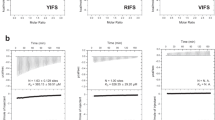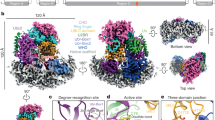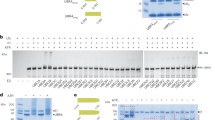Abstract
The N-end rule links the half-life of a protein to the identity of its N-terminal residue. Destabilizing N-terminal residues are recognized by E3 ubiquitin ligases, termed N-recognins. A conserved structural domain called the UBR box is responsible for their specificity. Here we report the crystal structures of the UBR boxes of the human N-recognins UBR1 and UBR2, alone and in complex with an N-end rule peptide, Arg-Ile-Phe-Ser. These structures show that the UBR box adopts a previously undescribed fold stabilized through the binding of three zinc ions to form a binding pocket for type 1 N-degrons. NMR experiments reveal a preference for N-terminal arginine. Peptide binding is abrogated by N-terminal acetylation of the peptide or loss of the positive charge of the N-terminal residue. These results rationalize and refine the empirical rules for the classification of type 1 N-degrons. We also confirm that a missense mutation in UBR1 that is responsible for Johanson-Blizzard syndrome leads to UBR box unfolding and loss of function.
This is a preview of subscription content, access via your institution
Access options
Subscribe to this journal
Receive 12 print issues and online access
$189.00 per year
only $15.75 per issue
Buy this article
- Purchase on Springer Link
- Instant access to full article PDF
Prices may be subject to local taxes which are calculated during checkout



Similar content being viewed by others
References
Hershko, A. & Ciechanover, A. The ubiquitin system. Annu. Rev. Biochem. 67, 425–479 (1998).
Bachmair, A., Finley, D. & Varshavsky, A. In vivo half-life of a protein is a function of its amino-terminal residue. Science 234, 179–186 (1986).
Varshavsky, A. The N-end rule. Cold Spring Harb. Symp. Quant. Biol. 60, 461–478 (1995).
Bachmair, A. & Varshavsky, A. The degradation signal in a short-lived protein. Cell 56, 1019–1032 (1989).
Varshavsky, A. Discovery of cellular regulation by protein degradation. J. Biol. Chem. 283, 34469–34489 (2008).
Tasaki, T. et al. Biochemical and genetic studies of UBR3, a ubiquitin ligase with a function in olfactory and other sensory systems. J. Biol. Chem. 282, 18510–18520 (2007).
Tasaki, T. et al. A family of mammalian E3 ubiquitin ligases that contain the UBR box motif and recognize N-degrons. Mol. Cell. Biol. 25, 7120–7136 (2005).
Tasaki, T. et al. The substrate recognition domains of the N-end rule pathway. J. Biol. Chem. 284, 1884–1895 (2009).
Xia, Z. et al. Substrate-binding sites of UBR1, the ubiquitin ligase of the N-end rule pathway. J. Biol. Chem. 283, 24011–24028 (2008).
Hwang, C.S., Shemorry, A. & Varshavsky, A. N-terminal acetylation of cellular proteins creates specific degradation signals. Science 327, 973–977 (2010).
Johanson, A. & Blizzard, R. A syndrome of congenital aplasia of the alae nasi, deafness, hypothyroidism, dwarfism, absent permanent teeth, and malabsorption. J. Pediatr. 79, 982–987 (1971).
Zenker, M. et al. Deficiency of UBR1, a ubiquitin ligase of the N-end rule pathway, causes pancreatic dysfunction, malformations and mental retardation (Johanson-Blizzard syndrome). Nat. Genet. 37, 1345–1350 (2005).
Kwon, Y.T., Xia, Z., Davydov, I.V., Lecker, S.H. & Varshavsky, A. Construction and analysis of mouse strains lacking the ubiquitin ligase UBR1 (E3α) of the N-end rule pathway. Mol. Cell. Biol. 21, 8007–8021 (2001).
Kwon, Y.T. et al. Female lethality and apoptosis of spermatocytes in mice lacking the UBR2 ubiquitin ligase of the N-end rule pathway. Mol. Cell. Biol. 23, 8255–8271 (2003).
An, J.Y. et al. UBR2 mediates transcriptional silencing during spermatogenesis via histone ubiquitination. Proc. Natl. Acad. Sci. USA 107, 1912–1917 (2010).
Ouyang, Y. et al. Loss of Ubr2, an E3 ubiquitin ligase, leads to chromosome fragility and impaired homologous recombinational repair. Mutat. Res. 596, 64–75 (2006).
Holm, L., Kaariainen, S., Rosenstrom, P. & Schenkel, A. Searching protein structure databases with DaliLite v.3. Bioinformatics 24, 2780–2781 (2008).
de Groot, R.J., Rumenapf, T., Kuhn, R.J., Strauss, E.G. & Strauss, J.H. Sindbis virus RNA polymerase is degraded by the N-end rule pathway. Proc. Natl. Acad. Sci. USA 88, 8967–8971 (1991).
Levitt, M. & Perutz, M.F. Aromatic rings act as hydrogen bond acceptors. J. Mol. Biol. 201, 751–754 (1988).
Tasaki, T. & Kwon, Y.T. The mammalian N-end rule pathway: new insights into its components and physiological roles. Trends Biochem. Sci. 32, 520–528 (2007).
Gil, P. et al. BIG: a calossin-like protein required for polar auxin transport in Arabidopsis. Genes Dev. 15, 1985–1997 (2001).
Kwon, Y.T. et al. An essential role of N-terminal arginylation in cardiovascular development. Science 297, 96–99 (2002).
Brower, C.S. & Varshavsky, A. Ablation of arginylation in the mouse N-end rule pathway: loss of fat, higher metabolic rate, damaged spermatogenesis, and neurological perturbations. PLoS ONE 4, e7757 (2009).
Graciet, E. et al. The N-end rule pathway controls multiple functions during Arabidopsis shoot and leaf development. Proc. Natl. Acad. Sci. USA 106, 13618–13623 (2009).
Holman, T.J. et al. The N-end rule pathway promotes seed germination and establishment through removal of ABA sensitivity in Arabidopsis. Proc. Natl. Acad. Sci. USA 106, 4549–4554 (2009).
Otwinowski, Z. & Minor, W. Processing of X-ray diffraction data collected in oscillation mode. Methods Enzymol. 276, 307–326 (1997).
Terwilliger, T.C. Maximum-likelihood density modification. Acta Crystallogr. D Biol. Crystallogr. 56, 965–972 (2000).
Emsley, P. & Cowtan, K. Coot: model-building tools for molecular graphics. Acta Crystallogr. D Biol. Crystallogr. 60, 2126–2132 (2004).
Murshudov, G.N., Vagin, A.A., Lebedev, A., Wilson, K.S. & Dodson, E.J. Efficient anisotropic refinement of macromolecular structures using FFT. Acta Crystallogr. D Biol. Crystallogr. 55, 247–255 (1999).
Winn, M.D., Murshudov, G.N. & Papiz, M.Z. Macromolecular TLS refinement in REFMAC at moderate resolutions. Methods Enzymol. 374, 300–321 (2003).
Delaglio, F. et al. NMRPipe: a multidimensional spectral processing system based on UNIX pipes. J. Biomol. NMR 6, 277–293 (1995).
Bartels, C., Xia, T.H., Billeter, M., Guntert, P. & Wuthrich, K. The program XEASY for computer-supported NMR spectral analysis of biological macromolecules. J. Biomol. NMR 6, 1–10 (1995).
Acknowledgements
We thank J.-F. Trempe and M. Ménade for technical assistance and helpful discussions. E.M.C. is funded by the Canadian Institutes of Health Research (CIHR) and McGill University. Data acquisition at the Macromolecular Diffraction (MacCHESS) facility at the Cornell High Energy Synchrotron Source (CHESS) was supported by US National Science Foundation award DMR 0225180 and US National Institutes of Health award RR-01646. This study was funded by CIHR grant MOP-14219.
Author information
Authors and Affiliations
Corresponding author
Ethics declarations
Competing interests
The authors declare no competing financial interests.
Supplementary information
Supplementary Text and Figures
Supplementary Figures 1–5 (PDF 3015 kb)
Rights and permissions
About this article
Cite this article
Matta-Camacho, E., Kozlov, G., Li, F. et al. Structural basis of substrate recognition and specificity in the N-end rule pathway. Nat Struct Mol Biol 17, 1182–1187 (2010). https://doi.org/10.1038/nsmb.1894
Received:
Accepted:
Published:
Issue Date:
DOI: https://doi.org/10.1038/nsmb.1894
This article is cited by
-
UBE2A and UBE2B are recruited by an atypical E3 ligase module in UBR4
Nature Structural & Molecular Biology (2024)
-
Structural snapshots along K48-linked ubiquitin chain formation by the HECT E3 UBR5
Nature Chemical Biology (2024)
-
Insights into the recognition mechanism in the UBR box of UBR4 for its specific substrates
Communications Biology (2023)
-
N-terminal acetylation shields proteins from degradation and promotes age-dependent motility and longevity
Nature Communications (2023)
-
Molecular basis for ubiquitin ligase CRL2FEM1C-mediated recognition of C-degron
Nature Chemical Biology (2021)



